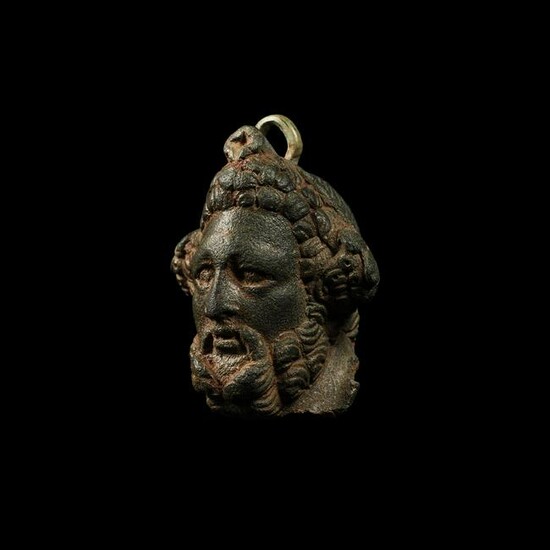'The Alvescot' Roman Steelyard Weight
c.43-402 AD. The second largest steelyard weight recorded on the PAS database; a large bronze steelyard weight formed as the bust of Jupiter (Greek Zeus), the god of the sky and thunder; the head naturalistically modelled with projecting nose and strong brow, oval depressions for eyes with domed eyeballs suggesting that they were not intended to be filled with enamel, full lips framed by carefully dressed beard; the hair gathered up into three coiffured bunches, two of the bunches covering the ears and the third one placed at the apex of the head; a circular laurel wreath with a diadem at its apex resting behind the bunches, an applied suspension loop to the top of the head; the lower part lost revealing the lead core. See Portable Antiquities Scheme, record no. BH-9A1197, for a similar but substantially smaller steelyard weight modelled as head of Jupiter and record no. SF-FA1DF5, for a weight modelled as a head of a deity; see also Biddle, M. & Henig, M., A Jupiter temple (?) outside the west gate of Venta Belgarum and the development of Winchester’s western suburb, London, 2018; Allason-Jones, L. & Miket, R., Catalogue of Small Finds from South Shields Roman Fort, Gloucester, 1984. Sally Worrel, Phil Smither and Edward Caswell A Roman settlement that was worth the weight, a PAS and OMS Oxfordshire Museum Service publication, 2020. 455 grams, 63mm (2 1/2"). Found while searching with a metal detector on Sunday 27th September 2020 near Alvescot, West Oxfordshire, UK, by Steven Clarke; accompanied by a copy of Portable Antiquities Scheme report number: OXON-4391B5, and a copy of Oxford Museum Service publication about the piece and associated finds by Sally Worrel, Phil Smither and Edward Caswell titled 'A Roman settlement that was worth the weight'. ; this lot has been checked against the Interpol Database of stolen works of art and is accompanied by AIAD certificate number no.10853-178277. The weight measures more than one Roman libra, weighing between an extra triens (one third/four twelfths of a libra) and an extra quincunx (five twelfths of a libra"). It is the second largest steelyard weight on the Portable Antiquities Scheme database and one of the larger examples from Roman Britain. In terms of size, it is paralleled by only a few others, including a head of Silenus from Richborough and a female head from Kingscote villa. The weight is particularly similar to a bronze bust, found close to the west gate Venta Belgarum near Winchester, that has been identified as a bust of Jupiter (Biddle and Henig, 2018) and which shares the same facial features, beard and hair on the back of the head. [A video of this lot can be viewed on the Timeline Auctions website]
Condition Report: Fine condition. The second largest recorded steelyard weight.
View it on
Sale price
Estimate
Time, Location
Auction House
c.43-402 AD. The second largest steelyard weight recorded on the PAS database; a large bronze steelyard weight formed as the bust of Jupiter (Greek Zeus), the god of the sky and thunder; the head naturalistically modelled with projecting nose and strong brow, oval depressions for eyes with domed eyeballs suggesting that they were not intended to be filled with enamel, full lips framed by carefully dressed beard; the hair gathered up into three coiffured bunches, two of the bunches covering the ears and the third one placed at the apex of the head; a circular laurel wreath with a diadem at its apex resting behind the bunches, an applied suspension loop to the top of the head; the lower part lost revealing the lead core. See Portable Antiquities Scheme, record no. BH-9A1197, for a similar but substantially smaller steelyard weight modelled as head of Jupiter and record no. SF-FA1DF5, for a weight modelled as a head of a deity; see also Biddle, M. & Henig, M., A Jupiter temple (?) outside the west gate of Venta Belgarum and the development of Winchester’s western suburb, London, 2018; Allason-Jones, L. & Miket, R., Catalogue of Small Finds from South Shields Roman Fort, Gloucester, 1984. Sally Worrel, Phil Smither and Edward Caswell A Roman settlement that was worth the weight, a PAS and OMS Oxfordshire Museum Service publication, 2020. 455 grams, 63mm (2 1/2"). Found while searching with a metal detector on Sunday 27th September 2020 near Alvescot, West Oxfordshire, UK, by Steven Clarke; accompanied by a copy of Portable Antiquities Scheme report number: OXON-4391B5, and a copy of Oxford Museum Service publication about the piece and associated finds by Sally Worrel, Phil Smither and Edward Caswell titled 'A Roman settlement that was worth the weight'. ; this lot has been checked against the Interpol Database of stolen works of art and is accompanied by AIAD certificate number no.10853-178277. The weight measures more than one Roman libra, weighing between an extra triens (one third/four twelfths of a libra) and an extra quincunx (five twelfths of a libra"). It is the second largest steelyard weight on the Portable Antiquities Scheme database and one of the larger examples from Roman Britain. In terms of size, it is paralleled by only a few others, including a head of Silenus from Richborough and a female head from Kingscote villa. The weight is particularly similar to a bronze bust, found close to the west gate Venta Belgarum near Winchester, that has been identified as a bust of Jupiter (Biddle and Henig, 2018) and which shares the same facial features, beard and hair on the back of the head. [A video of this lot can be viewed on the Timeline Auctions website]
Condition Report: Fine condition. The second largest recorded steelyard weight.



